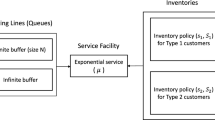Abstract
Queueing inventory models are extensively analysed since 1992. Very few among these discuss multi-commodity system. In this paper, we present a multi-commodity queueing inventory problem involving one essential and a set of m optional item(s). Immediately after the service of an essential item, the customer either leaves the system with probability p or with probability 1-p he goes for optional item(s). However, in the absence of an essential item, service will not be provided. More than one optional item can be demanded by the customer. The i th optional item or i th and j th optional items or i th, j th and k th and so on or all the optional items together, could be demanded by a customer, with probabilities \(p_{i}\), \(p_{ij}\), \(p_{ijk}\) \(\ldots \) \(p_{12\ldots m}\) respectively. If the demanded optional item(s) is(are) not available, the customer leaves the system after purchasing the essential item. With the arrival of customers forming Markovian Arrival Process (MAP), service time of essential item Phase type distributed and that for optional items exponentially distributed( depending on the type(s) of item(s)), all given by the same (single) server, we analyse the system. Then we obtain the system state probability distribution. In-order to get a picture of how the system performs, we derive several characteristics of the system. With control policies for essential and optional items determined respectively, by (s, S) and (\(s_{i}\),\(S_{i}\)),\(i=1,2,3,\)..., m, we investigate the optimal values of \(s,S,s_{i}\) and \(S_{i}\)s’. To this end, we set up a cost function, involving these control variables.

Similar content being viewed by others
References
Araya-Sassi, C., Paredes-Belmar, G., & Gutiérrez-Jarpa, G. (2020). Multi-commodity inventory-location problem with two different review inventory control policies and modular stochastic capacity constraints. Computers and Industrial Engineering. https://doi.org/10.1016/j.cie.2020.106410.
Askin, R. G., Baffo, I., & Xia, M. (2014). Multi-commodity warehouse location and distribution planning with inventory consideration. International Journal of Production Research, 52(7), 1897–1910.
Baek, J. W., & Moon, S. K. (2014). The \(M/M/1\) queue with a production-inventory system and lost sales. Applied Mathematics and Computation, 233, 534–544.
Berman, O., Kaplan, E. H., & Shimshak, D. G. (1993). Deterministic approximations for inventory management at service facilities. IIE Transactions, 25(5), 98–104.
Berman, O., & Kim, E. (1999). Stochastic models for inventory managements at service facilities. Communications in Statistics Stochastic Models, 15(4), 695–718.
Berman, O., & Sapna, K. P. (2002). Optimal service rates of a service facility with perishable inventory items. Naval Research Logistic, 49, 464–482.
Chakravarthy, S. R. (2001). The batch Markovian arrival process: A review and future work. In A. Krishnamoorthy, et al. (Eds.), Advances in probability theory and stochastic process (pp. 21–49). New Jersey, NJ: Notable Publications.
Daduna, H. (2020). Graph-based mobility models: Asymptotic and stationary node distribution. In H. Hermanns (Ed.), Measurement, modelling and evaluation of computing systems. MMB 2020. Lecture notes in computer science (Vol. 12040). Cham: Springer. https://doi.org/10.1007/978-3-030-43024-5-10.
Daduna, H., & Krenzler, R. (2020). Performance analysis for loss systems with many subscribers and concurrent services. In H. Hermanns (Ed.), Measurement, modelling and evaluation of computing systems. MMB 2020. Lecture notes in computer science (Vol. 12040). Cham: Springer. https://doi.org/10.1007/978-3-030-43024-5-8.
Faiz, A.-K., & Hwang, S.-J. (2007). Inventory constrained maritime routing and scheduling for multi- commodity liquid bulk, Part I: Applications and model. European Journal of Operational Research, 176(1), 106–130.
Jin, Q. I. N., Feng, S. H. I., Miao, L. X., & Tan, G. J. (2009). Optimal model and algorithm for multi-commodity logistics network design considering stochastic demand and inventory control. Systems Engineering Theory & Practice, 29(4), 176–183.
Krishnamoorthy, A., Shajin, D., & Viswanath, C. N. (2019). Inventory with positive service time: A survey. In V. Anisimov & N. Limnios (Eds.), Advanced trends in queueing theory: Series of books “Mathematics and Statistics”. London: Sciences, ISTE & J. Wiley.
Krishnamoorthy, A., & Viswanath, N. C. (2013). Stochastic decomposition in production inventory with service time. EJOR,. https://doi.org/10.1016/j.ejor.2013.01.041.
Melikov, A. Z., & Molchanov, A. A. (1992). Stock optimization in transportation/storage systems. Cybernetics and Systems Analysis, 28(3), 484–487.
Neuts, M. F. (1981). Matrix-geometric solutions in stochastic models: An algorithmic approach. Baltimore: The Johns Hopkins University Press. [1994 version is Dover Edition].
Otten, S., Krenzler, R., & Daduna, H. (2020). Separable models for interconnected production-inventory systems. Stochastic Models, 36(1), 48–93. https://doi.org/10.1080/15326349.2019.1692667.
Sadjady, H., & Davoudpour, H. (2012). Two-echelon, multi-commodity supply chain network design with mode selection, lead-times and inventory costs. Computers and Operations Research, 39(7), 1345–1354.
Saffari, M., Asmussen, S., & Haji, R. (2013). The M/M/1 queue with inventory, lost sale and general lead times. Queueing Systems, 2013, https://doi.org/10.1007/s11134-012-9337-3.
Schwarz, M., & Daduna, H. (2006). Queueing systems with inventory management with random lead times and with backordering. Mathematical Methods of Operations Research, 64, 383–414.
Schwarz, M., Sauer, C., Daduna, H., Kulik, R., & Szekli, R. (2006). M/M/1 queueing systems with inventory. Queueing System, 54, 55–78.
Schwarz, M., Wichelhaus, C., & Daduna, H. (2007). Product form models for queueing networks with an inventory. Stochastic Models, 23(4), 627–663.
Sigman, K., & Simchi-Levi, D. (1992). Light traffic heuristic for an M/G/1 queue with limited inventory. Annals of Operation Research, 1992(40), 371–380.
Zadeh, A. S., Sahraeian, R., & Homayouni, M. (2013). A dynamic multi-commodity inventory and facility location problem in steel supply chain network design. International Journal of Advanced Manufacturing Technology, 70(5–8), 1267–1282. https://doi.org/10.1007/s00170-013-5358-2.
Author information
Authors and Affiliations
Corresponding author
Additional information
Publisher's Note
Springer Nature remains neutral with regard to jurisdictional claims in published maps and institutional affiliations.
Research supported by UGC No.F.6-6/2017-18/EMERITUS-2017-18-GEN-10822(SA-II) and DST Project INT/RUS/RSF/P-5.
Rights and permissions
About this article
Cite this article
Shajin, D., Jacob, J. & Krishnamoorthy, A. On a queueing inventory problem with necessary and optional inventories. Ann Oper Res 315, 2089–2114 (2022). https://doi.org/10.1007/s10479-021-03975-8
Accepted:
Published:
Issue Date:
DOI: https://doi.org/10.1007/s10479-021-03975-8




